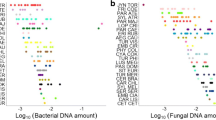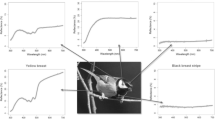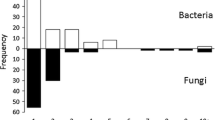Abstract
Microorganisms have been shown to play an important role in shaping the life histories of animals, and it has recently been suggested that feather-degrading bacteria influence the trade-off between parental effort and self-preening behavior in birds. We studied a wild breeding population of great tits (Parus major) to explore habitat-, seasonal-, and sex-related variation in feather-degrading and free-living bacteria inhabiting the birds' yellow ventral feathers and to investigate associations with body condition. The density and species richness of bacterial assemblages was studied using flow cytometry and ribosomal intergenic spacer analysis. The density of studied bacteria declined between the nest-building period and the first brood. The number of bacterial phylotypes per bird was higher in coniferous habitat, while bacterial densities were higher in deciduous habitat. Free-living bacterial density was positively correlated with female mass; conversely, there was a negative correlation between attached bacterial density and female mass during the period of peak reproductive effort. Bacterial species richness was sex dependent, with more diverse bacterial assemblages present on males than females. Thus, this study revealed that bacterial assemblages on the feathers of breeding birds are affected both by life history and ecological factors and are related to body condition.


Similar content being viewed by others
References
Clayton DH (1999) Feather-busting bacteria. Auk 116:302–304
Hackstein JHP, Van Alen TA (1996) Fecal methanogens and vertebrate evolution. Evolution 50:559–572
Nuttall PA (1997) Viruses, bacteria and fungi of birds. In: Clayton DH, Moore J (eds) Host–parasite evolution: general principles and avian models. Oxford University Press, Oxford, p 271
Burtt EH, Ichida JM (1999) Occurrence of feather-degrading bacilli in the plumage of birds. Auk 116:364–372
Lucas FS, Moureau B, Jourdie V, Heeb P (2005) Brood size modifications affect plumage bacterial assemblages of European starlings. Mol Ecol 14:639–646
Shawkey MD, Mills KL, Dale C, Hill GE (2005) Microbial diversity of wild bird feathers revealed through culture-based and culture-independent techniques. Microb Ecol 50:40–47
Clayton DH, Moore J (eds) (1997) Host–parasite evolution: general principles and avian models. Oxford University Press, Oxford
Muza MM, Burtt EH, Ichida JM (2000) Distribution of bacteria on feathers of some eastern North American birds. Wilson Bull 112:432–435
Gunderson AR, Forsyth MH, Swaddle JP (2009) Evidence that plumage bacteria influence feather coloration and body condition of eastern bluebirds Sialia sialis. J Avian Biol 40:440–447
Hart BL (1997) Behavioural defense. In: Clayton DH, Moore J (eds) Host–parasite evolution: general principles and avian models. Oxford University Press, Oxford, pp 59–77
Shawkey MD, Pillai SR, Hill GE (2003) Chemical warfare? Effects of uropygial oil on feather-degrading bacteria. J Avian Biol 34:345–349
Reneerkens J, Versteegh MA, Schneider AM, Piersma T, Burtt EH (2008) Seasonally chancing preen-wax composition: Red Knots' (Calidris canutus) flexible defense against feather-degrading bacteria? Auk 125:285–290
Møller AP, Czirjak GA, Heeb P (2009) Feather micro-organisms and uropygial antimicrobial defences in a colonial passerine bird. Funct Ecol 23:1097–1102
Sangali S, Brandelli A (2000) Isolation and characterization of a novel feather-degrading bacterial strain. Applied Biochemistry and Biotechnology—Part A Enzyme Engineering and Biotechnology 87:17–24
Lucas FS, Broennimann O, Febbraro I, Heeb P (2003) High diversity among feather-degrading bacteria from a dry meadow soil. Microb Ecol 45:282–290
Riffel A, Lucas F, Heeb P, Brandelli A (2003) Characterization of a new keratinolytic bacterium that completely degrades native feather keratin. Arch Microbiol 179:258–265
Brush A (1965) Energetics, temperature regulation and circulation in resting, active and defeathered California quail, Lophortyx californicus. Comp Biochem Physiol, Part A Mol Integr Physiol 15:399–421
Swaddle JP, Witter MS, Cuthill IC, Budden A, McCowen P (1996) Plumage condition affects flight performance in common starlings: implications for developmental homeostasis, abrasion and moult. J Avian Biol 27:103–111
Merilä J, Hemborg C (2000) Fitness and feather wear in the collared flycatcher Ficedula albicollis. J Avian Biol 31:504–510
Shawkey MD, Pillai SR, Hill GE, Siefferman LM, Roberts SR (2007) Bacteria as an agent for change in structural plumage color: correlational and experimental evidence. Am Nat 169:S112–S121
Shawkey MD, Pillai SR, Hill GE (2009) Do feather-degrading bacteria affect sexually selected plumage color? Naturwissenschaften 96:123–128
Burtt EH (2009) A future with feather-degrading bacteria. J Avian Biol 40:349–351
Peele AM, Burtt EH Jr, Schroeder MR, Greenberg RS (2009) Dark color of the coastal plain swamp sparrow (Melospiza georgiana nigrescens) may be an evolutionary response to occurrence and abundance of salt-tolerant feather-degrading bacilli in its plumage. Auk 126:531–535
Burtt EH, Ichida JM (2004) Gloger's rule, feather-degrading bacteria, and color variation among song sparrows. Condor 106:681–686
Cristol DA, Armstrong JL, Whitaker JM, Forsyth MH (2005) Feather-degrading bacteria do not affect feathers on captive birds. Auk 122:222–230
Saranathan V, Burtt EH (2007) Sunlight on feathers inhibits feather-degrading bacteria. Wilson J Ornithol 119:239–245
Bisson IA, Marra PP, Burtt EH Jr, Sikaroodi M, Gillevet PM (2007) A molecular comparison of plumage and soil bacteria across biogeographic, ecological, and taxonomic scales. Microb Ecol 54:65–81
Bisson IA, Marra PP, Burtt EH Jr, Sikaroodi M, Gillevet PM (2009) Variation in plumage microbiota depends on season and migration. Microb Ecol 58:212–220
Mägi M, Mänd R (2004) Habitat differences in allocation of eggs between successive breeding attempts in great tits (Parus major). Ecoscience 11:361–369
Mänd R, Tilgar V, Lõhmus A, Leivits A (2005) Providing nest boxes for hole-nesting birds—does habitat matter? Biodivers Conserv 14:1823–1840
Graveland J, van Gijzen T (1994) Arthropods and seeds are not sufficient as calcium sources for shell formation and skeletal growth in passerines. Ardea 82:299–314
Tilgar V, Mänd R (2006) Sibling growth patterns in great tits: does increased selection on last-hatched chicks favour an asynchronous hatching strategy? Evol Ecol 20:217–234
Lucas FS, Bertru G, Hofle MG (2003) Characterization of free-living and attached bacteria in sediments colonized by Hediste diversicolor. Aquat Microb Ecol 32:165–174
Muyzer G, Dewaal EC, Uitterlinden AG (1993) Profiling of complex microbial populations by denaturing gradient gel-electrophoresis analysis of polymerase chain reaction-amplified genes coding for 16S rRNA. Appl Environ Microbiol 59:695–700
Stach JEM, Maldonado LA, Masson DG, Ward AC, Goodfellow M, Bull AT (2003) Statistical approaches for estimating actinobacterial diverity in marine sediments. Appl Environ Microbiol 69:6189–6200
Ranjard L, Poly F, Nazaret S (2000) Monitoring complex bacterial communities using culture-independent molecular techniques: application to soil environment. Res Microbiol 151:167–177
Ranjard L, Brothier E, Nazaret S (2000) Sequencing bands of ribosomal intergenic spacer analysis fingerprints for characterization and microscale distribution of soil bacterium populations responding to mercury spiking. Appl Environ Microbiol 66:5334–5339
Ozawa T, Yamaguchi M (1986) Fractionation and estimation of particle-attached and unattached Bradyrhizobium japonicum strains in soils. Appl Environ Microbiol 52:911–914
Selje N, Simon M (2003) Composition and dynamics of particle-associated and free-living bacterial communities in the Weser estuary, Germany. Aquat Microb Ecol 30:221–237
Ichida JM, Krizova L, LeFevre CA, Keener HM, Elwell DL, Burtt EH (2001) Bacterial inoculum enhances keratin degradation and biofilm formation in poultry compost. J Microbiol Methods 47:199–208
Merilä J, Wiggins DA (1997) Mass loss in breeding blue tits: the role of enerfetic stress. J Anim Ecol 66:452–460
Tinbergen JM, Dietz MW (1994) Parental energy expenditure during brood rearing in the Great Tit (Parus major) in relation to body mass, temperature, food availability and clutch size. Funct Ecol 8:563–572
Slagsvold T, Lifjeld JT (1990) Influence of male and female quality on clutch size in tits (Parus spp.). Ecology 71:1258–1266
Cramp S, Perrins CM (eds) (1993) The birds of the Western Palearctic, vol. VII. Oxford University Press, Oxford
Adams J (2009) Species richness: patterns in the diversity of life. Springer-Praxis, Berlin
Riley MA, Wertz JE (2002) Bacteriocin diversity: ecological and evolutionary perspectives. Biochimie 84:357–364
Peralta-Sanchez JM, Møller AP, Martin-Platero AM, Soler JJ (2010) Number and colour composition of nest lining feathers predict eggshell bacterial community in barn swallow nests: an experimental study. Funct Ecol 24:426–433
Martin-Platero AM, Valdivia E, Ruiz-Rodriguez M, Soler JJ, Martin-Vivaldi M, Maqueda M, Martinez-Bueno M (2006) Characterization of antimicrobial substances produced by Enterococcus faecalis MRR 10-3, isolated from the uropygial gland of the hoopoe (Upupa epops). Appl Environ Microbiol 72:4245–4249
Soler JJ, Martin-Vivaldi M, Ruiz-Rodriguez M, Valdivia E, Martin-Platero AM, Martinez-Bueno M, Peralta-Sanchez JM, Mendez M (2008) Symbiotic association between hoopoes and antibiotic-producing bacteria that live in their uropygial gland. Funct Ecol 22:864–871
Kilgas P, Mänd R, Mägi M, Tilgar V (2006) Hematological parameters in brood-rearing great tits in relation to habitat, multiple breeding and sex. Comp Biochem Physiol, Part A Mol Integr Physiol 144:224–231
Kilgas P, Tilgar V, Mägi M, Mänd R (2007) Physiological condition of incubating and brood rearing female Great Tits Parus major in two contrasting habitats. Acta Ornithologica 42:129–136
Mägi M, Mänd R, Tamm H, Sisask E, Kilgas P, Tilgar V (2009) Low reproductive success of great tits in the preferred habitat: a role of food availability. Ecoscience 16:145–157
Verhulst S, Tinbergen JM (1997) Clutch size and parental effort in the great tit Parus major. Ardea 85:111–126
Sanz JJ, Kranenbarg S, Tinbergen JM (2000) Differential response by males and females to manipulation of partner contribution in the great tit (Parus major). J Anim Ecol 69:74–84
Acknowledgements
We are grateful to Veljo Kisand and his co-workers from the Molecular Microbiology Group of the Institute of Technology, University of Tartu, for valuable advice and laboratory assistance and to Elo Rasmann for her priceless help with fieldwork. John Davison made lots of useful comments on the manuscript. The study was financially supported by the Estonian Science Foundation (grant numbers 6908 and 8376), the Estonian Ministry of Education and Science (target-financing project number 0180004s09), and the European Union through the European Regional Development Fund (Center of Excellence FIBIR). The study complies with the current laws of Estonia.
Author information
Authors and Affiliations
Corresponding author
Rights and permissions
About this article
Cite this article
Saag, P., Tilgar, V., Mänd, R. et al. Plumage Bacterial Assemblages in a Breeding Wild Passerine: Relationships with Ecological Factors and Body Condition. Microb Ecol 61, 740–749 (2011). https://doi.org/10.1007/s00248-010-9789-0
Received:
Accepted:
Published:
Issue Date:
DOI: https://doi.org/10.1007/s00248-010-9789-0




